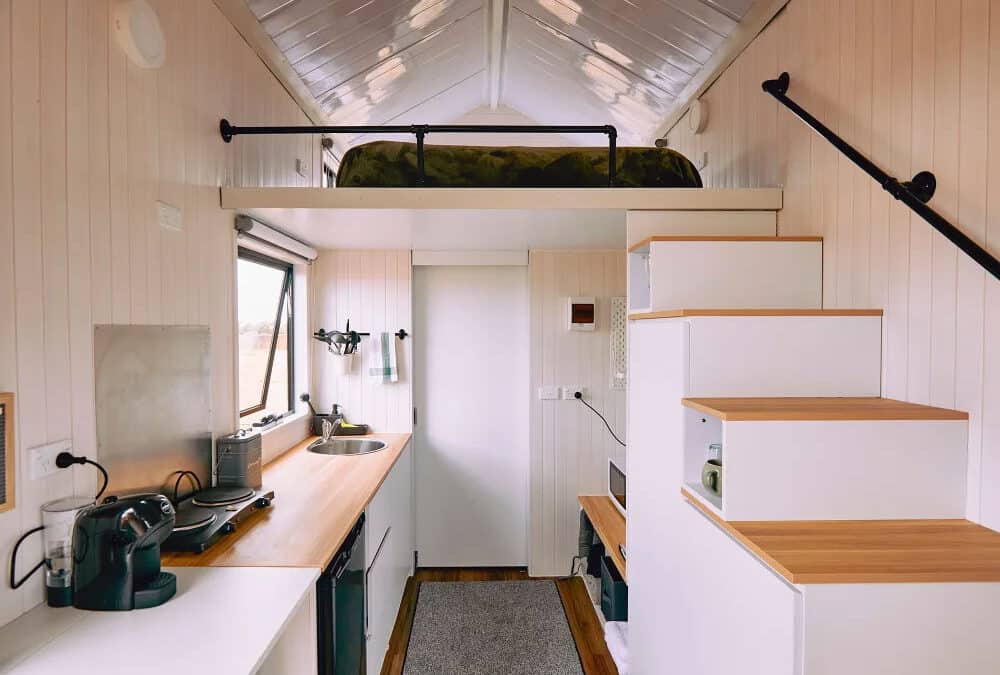Fine Print for Tiny Living: legal considerations for buyers and sellers!
In the evolving landscape of housing in Australia, tiny homes have surged in popularity as a sustainable and affordable alternative to traditional homeownership. However, the legalities surrounding the purchase, sale, and placement of tiny homes in Australia are nuanced and require careful consideration by both buyers and sellers. This article provides an overview of the key legal considerations, including land ownership, tiny home agreements for leasing land, and zoning regulations that impact the location of a tiny home.
.
Understanding Tiny Homes in Australia
Tiny homes in Australia must adhere to specific dimensions to be legally towed on the road 2.5m wide, 4.3m high, 12.5m long, and weigh no more than 4.5 tonnes [^1^]. While tiny houses on wheels are not required to comply with the Building Code of Australia (BCA) since they do not fit the classification for a permanent structure[^2^], it’s crucial for buyers and sellers to understand that different rules apply depending on whether the tiny home is intended to be mobile or a permanent fixture.
Land Ownership vs. Leasing
Land Ownership
Purchasers looking to own land for their tiny home face several legal considerations. Firstly, zoning laws play a crucial role; not all zones permit residential living in tiny homes, especially if considered temporary structures like caravans. Buyers must consult local council regulations to determine if their intended use aligns with zoning requirements. Additionally, building permits may be required for permanent tiny homes, following local council standards for safety, accessibility, and environmental impact.
.
Tiny Home Agreements for Leasing Land
For those not looking to purchase land, entering into a tiny home agreement for leasing land offers flexibility. These agreements should clearly define terms including lease duration, renewal options, responsibilities for maintenance, and conditions under which the agreement can be terminated. It’s essential for both parties to understand their rights and obligations under Australian consumer law, ensuring the tiny home is fit for purpose and the lease terms are fair [^3^].
Location and Legal Considerations
Choosing where to locate a tiny home involves navigating a complex web of legal considerations, from zoning laws to community by-laws and even the philosophy and approach of local legislatures [^4^]. Regulations on zoning and land use significantly impact living in a tiny home, dictating where one can legally park or place their home. For instance, some regions may allow tiny homes in residential areas under certain conditions, while others may restrict them to rural or industrial zones.
Zoning Laws
Zoning laws vary widely across Australia’s territories and councils, with each having its own set of rules concerning tiny homes. Generally, these laws address concerns related to liveable space, sunlight, and the impact on the surrounding community. Prospective tiny homeowners should engage with town planners or legal professionals knowledgeable about local zoning laws to ensure compliance [^5^].
Community Amenities and Regulations
When searching for a tiny home community or leasing land within an existing community, it’s important to consider community-specific regulations. These can include restrictions on the type of tiny homes allowed, architectural and design standards, and access to community amenities. Understanding these regulations upfront can prevent future disputes and ensure a harmonious living environment.
Environmental Considerations and Sustainability
Given the eco-friendly appeal of tiny homes, environmental considerations also play a role in legal and regulatory compliance. For instance, tiny homes must meet specific standards for waste management, water usage, and energy efficiency. Buyers planning to install solar panels or rainwater collection systems should verify that these installations comply with local regulations and standards.
Navigating Regulations for Small Living
Living in a tiny home in Australia presents a unique set of legal challenges, but also offers opportunities for innovation and sustainability in housing. Prospective buyers and sellers must stay informed about the changing landscape of regulations governing tiny homes. Consulting with professionals, from town planners to legal advisors, is paramount in navigating these waters successfully. By understanding the key legal considerations of tiny home purchasing, including land ownership and zoning laws, individuals can make informed decisions that align with their lifestyle goals and legal obligations.
In conclusion, the tiny home movement in Australia continues to grow, driven by the desire for simpler, more affordable living spaces. However, this trend also brings to light the complex legal framework within which tiny homes operate. Whether opting for land ownership or entering into a leasing agreement, understanding the legalities of tiny home purchasing is essential for a smooth transition to small living. With careful planning and adherence to regulations, tiny homes can offer a viable, enjoyable living solution for Australians seeking an alternative to traditional housing.
[^1^]: Aussie Tiny Houses
[^2^]: Tiny House Association Australia
[^3^]: Tiny House Association Australia
[^4^]: THIMBY
[^5^]: DLux Modular


